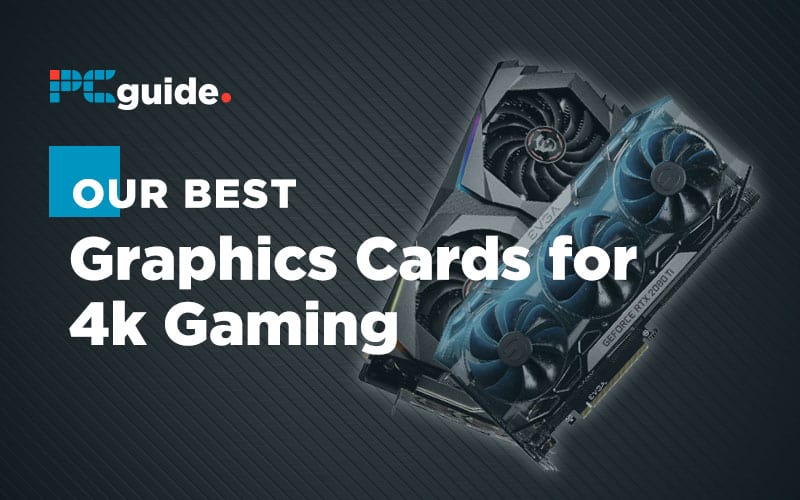As 4k gaming starts to become the norm, you’re going to want a graphics card that is capable of the future high resolution AAA titles that get released. Of course, with graphics cards of this calibre, you’re going to need deep pockets, especially with options like the Nvidia RTX 2080 Ti and Nvidia RTX 2080 Super. However, with our selection of best graphics cards for 4k gaming, we’ve tried to pander to the needs of a variety of individuals – even including an Radeon option for you AMD lovers out there. There is a ‘budget’ option too, which may seem contradicting to my previous statement, but by budget, we mean at a lower cost compared to the high ticket graphics cards that are simply unobtainable for most users.
Table of Contents
Best Performing 4k Gaming Graphics Card
EVGA GeForce RTX 2080 Ti FTW3 ULTRA GAMING
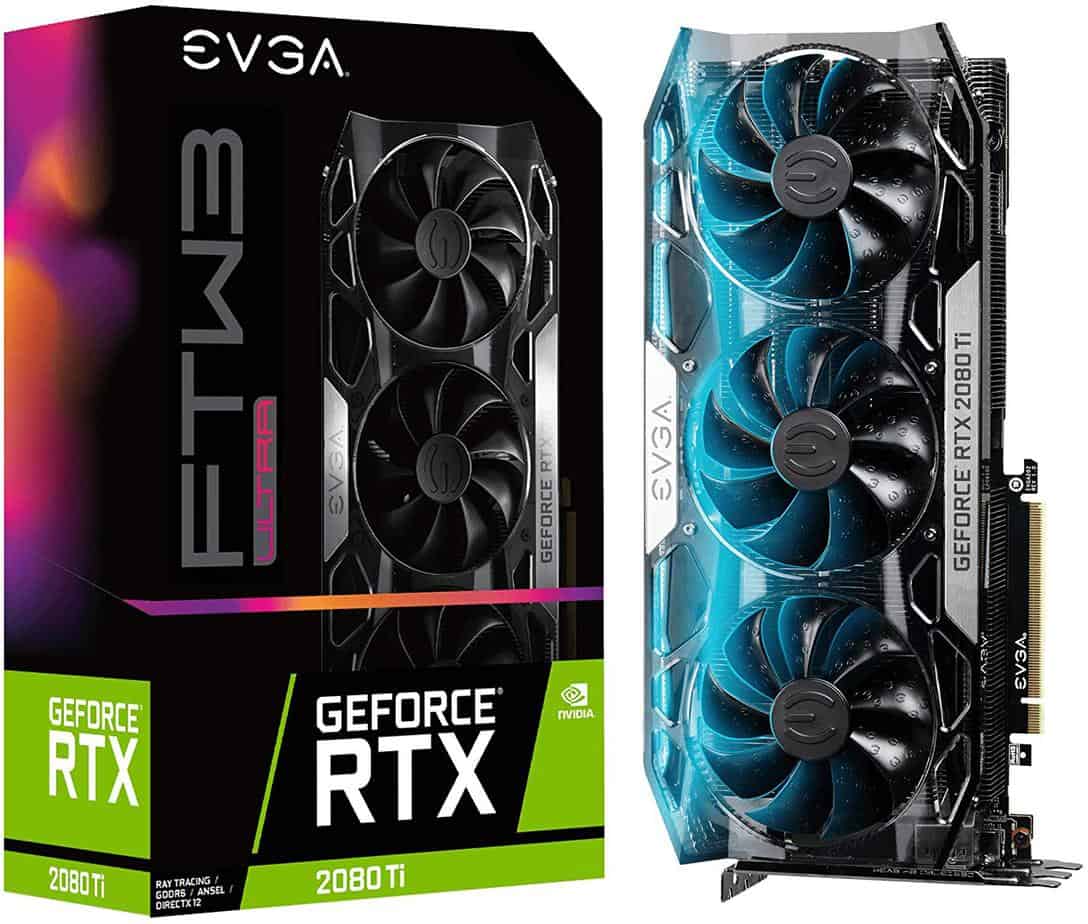
Boost Clock: 1755 MHz
VRAM: 11GB GDDR6
Width: 2.75-Slot
Length: 301 mm
Ports: 3 DP, 1 HDMI
- Best 4k gaming performance
- Great cooling
- Masses of RAM
- Good port options
- Expensive
The Nvidia RTX 2080 Ti is widely regarded as the top of the line graphics card offering up some of the best specs for consumers out there. This EVGA variant of the 2080 Ti is probably the one to go for here with its stellar build quality, optimal fan cooling and the all new EVGA Precision X1 software. When looking at the spec of this 4k gaming powerhouse, you’re going to be getting a 1,755 MHz boost clock speed alongside a whopping 11GB of DDR6 SDRAM allowing it to run all the latest games with ease. Additionally, with this being a Nvidia GPU, you are able to take advantage of some of the best technology out there. With Real-Time Ray Tracing, NVIDIA® GeForce Experience, NVIDIA® Ansel, NVIDIA® Highlights and NVIDIA® G-SYNC Compatibility, you can maximize and tailor your gaming experience for the specific titles you like to play. With this graphics card being as powerful as it is, it does require a lot of power. So, when either upgrading your current rig or building a new PC, ensure you have a gold rated, high wattage supply to give your components enough juice. After all these positives you might be thinking if there is anything actually wrong with this graphics card and the answer comes when you look at the price. It is a very expensive choice and that’s why we’ve classed it as the best performing graphics card for 4k gaming and not the best overall. That spot goes to the 2080 Super.
Best Overall 4k Gaming Graphics Card
ASUS ROG Strix GeForce RTX 2080 Super
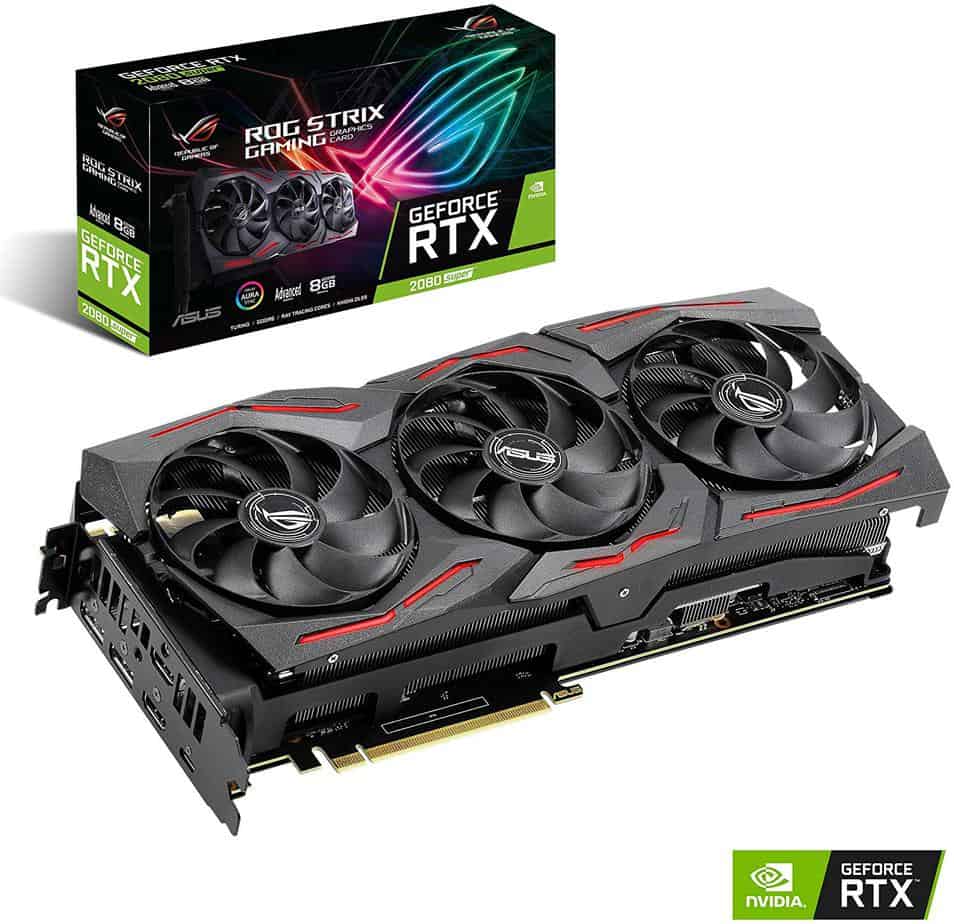
Boost Clock: 1860 MHz
VRAM: 8GB GDDR6
Width: 2.7-Slot
Length: 299 mm
Ports: 3 DP, 1 HDMI
- Good port options
- Best price vs performance for 4k gaming
- Great cooling
- Lacks RAM compared to 2080 Ti
Powered by Nvidia Turing with 3072 CUDA cores, the 2080 Super gives you the top performance required to run your favourite games at 4k resolutions. While it’s not as powerful as the 2080 Ti, you’ll be spending $500 less, making it a much more attractive option for most. We think that the ASUS ROG Strix GeForce RTX 2080 Super comes in as the top pick in this range, providing ASUS’ incredible FanConnect II and MaxContact technology, keeping temperatures at optimum levels coupled with improved thermal transfer. You’ll also be receiving a boost clock of 1,860 MHz and 8GB of DDR6 SDRAM, 3GB lower than the 2080 Ti, but more than enough for current gen 4k gaming. The variety of ports is also a big plus on this card with DisplayPort 1. 4, HDMI 2. 0 coupled with USB Type C ports for those looking to hook up a VR headset to play Half Life: Alyx for example. In terms of aesthetics, this card looks fantastic in any gaming PC, and with ASUS’ Aura Sync technology, the RGB lighting can be fully synced up proving that synergy throughout your setup. As previously mentioned, this RTX 2080 Super is a lot cheaper than its 2080 Ti and should still handle all the 4k gaming you need. It is, however, not as futureproof, so even though this is our best graphics card for 4k gaming overall, considering the 2080 Ti might be a more attractive option if you don't want to be switching components out.
Best Value 4k Gaming Graphics Card
EVGA GeForce RTX 2070 Super
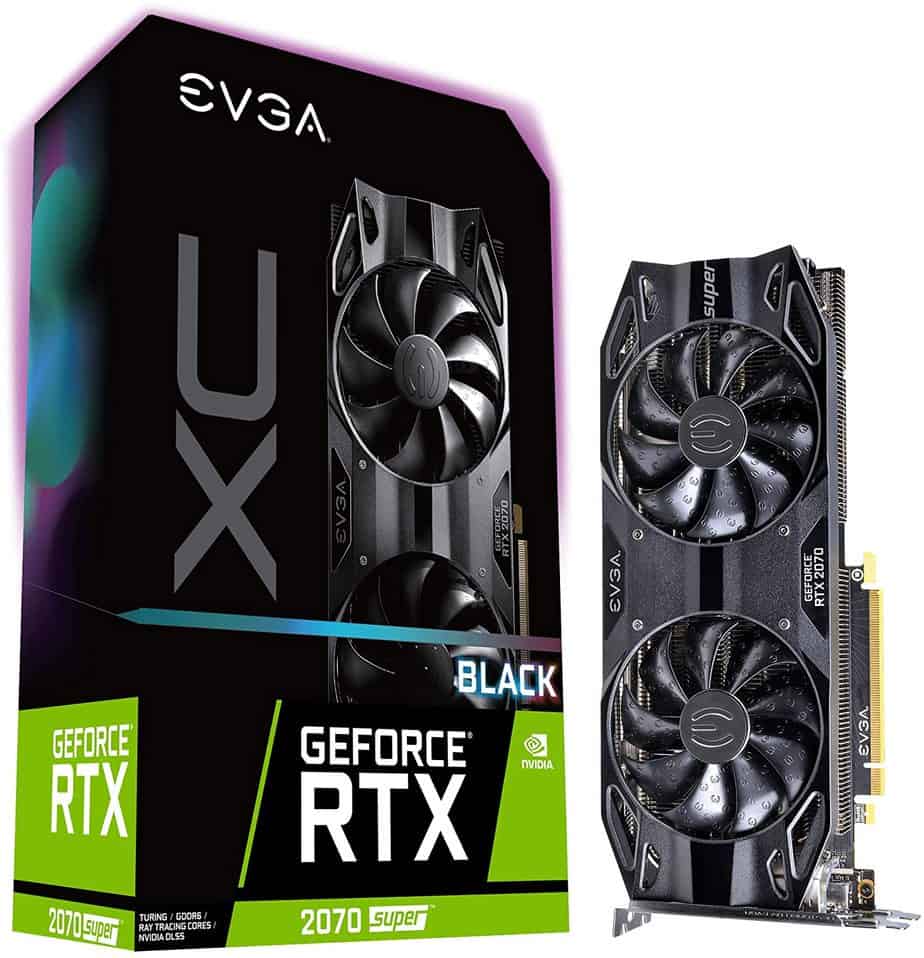
Boost Clock: 1770 MHz
VRAM: 8GB GDDR6
Width: 2-Slot
Length: 270 mm
Ports: 3 DP, 1 HDMI
- Fantastic value
- Great cooling
- Top build quality
- Not so futureproof
The RTX 2070 Super makes it onto our list of best graphics cards for 4k gaming in the best value spot for a few reasons; it gives some decent 4k gaming performance while also being much less expensive than the 2080 Ti and 2080 Super. With the EVGA RTX 2070 Super you’ll still be getting the real-time ray tracing that you get with the aforementioned more expensive graphics cards as well as all the specialized gaming tech from Nvidia. Surprisingly, you’ll be receiving 8GB of DDR6 SDRAM that goes into the much more expensive 2080 Super compounding the idea that this offers a real bang for your buck. Additionally, with this being an EVGA graphics card, you can benefit from most of the features of the RTX 2080 Ti in this list, while shelling out much less cash, further proof why it firmly cements its place as the best value graphics card for 4k gaming. If you’re wondering whether to opt for the older 1080 over the 2070 Super, well, they are at similar price ranges but for more futureproof features, almost always go for the more up to date 2070 Super.
Best AMD 4k Gaming Graphics Card
XFX AMD Radeon VII
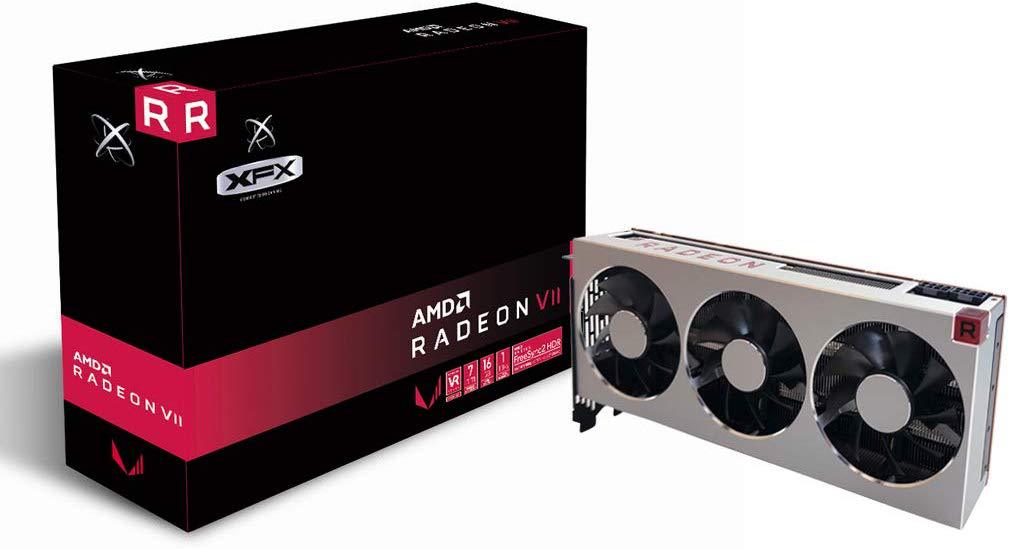
Boost Clock: 1750 MHz
VRAM: 16GB HBM2
Width: 2-Slot
Length: 305 mm
Ports: 3 DP, 1 HDMI
- Best AMD 4k gaming option
- Comparable with some Nvidia options
- Great cooling
- Not futureproof
- Lacking Nvidia technology
Before we get into the specifics of the Radeon VII, let’s first talk about why it's the only AMD graphics card on this list. While AMD makes some top quality graphics cards, ranging from budget to the more higher end picks, the performance does become a little lacking when looking at the top of the line products. The Radeon VII on the other hand is an attempt from AMD to break into the high performance, high price graphics cards, offering up some decent specs comparable to the base RTX 2080 model. It’s similarly priced too, which is a nice plus for those AMD lovers out there who simply just do not want an Nvidia graphics card in their rig. Looking at the actual specs of this thing, you’ll be getting a boost clock of 1750MHz, peaking at 1801 MHz which is impressive, almost matching 2080 Super levels. This one provides a different type of RAM with a total of 16GB HBM2 and while you may think this has more RAM than the 2080 Ti, you’ll be right, but whether that translates to performance improvements is a different story. When thinking on whether you’ll be getting decent frame rates for 4k gaming, well, the answer is yes. As stated previously, you are going to be receiving performance comparable to the base RTX 2080, running games like The Witcher 3 in Ultra settings at 47 FPS. We wouldn’t necessarily advise you to go for this graphics card when there’s better Nvidia options out there but if you can’t live without AMD, this is the one to go for.
Best Budget 4k Gaming Graphics Card
MSI Gaming GeForce RTX 2060 Super
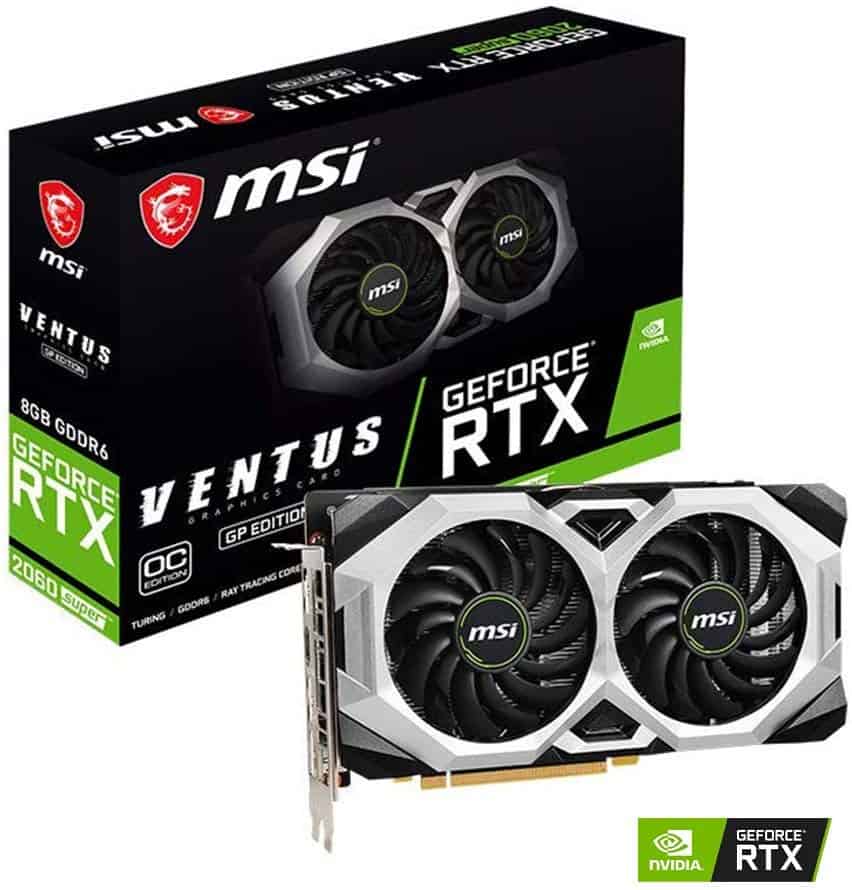
Boost Clock: 1665 MHz
VRAM: 8GB GDDR6
Width: 2.75-Slot
Length: 247 mm
Ports: 3 DP, 1 HDMI
- Fantastic value
- MSI manufactured
- Competes with higher priced cards
- Lackluster clock speedclock speed
The RTX 2060 Super comes in as our budget pick for the best graphics card for 4k gaming due to its surprising performance at such high resolutions. While this graphics card wasn’t specifically designed and marketed as a graphics card for 4k gaming, it offers up some decent benchmarks. You will however, need to turn down those graphical settings to have playable frame rates. Looking at the specs of the MSI Gaming GeForce RTX 2060 Super, you’ll get 8GB DDR6 RAM yet again, which you may not have expected in a graphics card so much lower in price than the 2070 Super. The boost clock comes in at 1665 MHz which is quite a bit lower than those more expensive options, but for price vs performance, you’re getting stellar value. Additionally, with this being manufactured by MSI, their Afterburner Overclocking software gives you full control of your graphics card and enables you to monitor your gaming rig’s performance in real-time. A big plus for those pushing this card to its limits. Speaking of limits, when pushing its gaming potential in 4k resolutions, you’ll be receiving around 10 FPS lower than the 2070 Super, a welcomed performance stat, furthering the reason why it should make it as our budget pick for best graphics card for 4k gaming.
Our Verdict
Overall, when looking at all of our picks for the best graphics card for 4k gaming, we think you should go for the 2080 Super due to the price vs performance aspect. It gives you a boost clock of 1,860 MHz and 8GB of DDR6 SDRAM which is more than enough to handle the top AAA at 4k resolutions while also being much cheaper than the 2080 Ti. However, if you do want the top of the line graphics card that is also a little more future proof, spend the extra money on the 2080 Ti. You’re getting that boost in performance with an additional 3GB of RAM. If budget is your top priority, the RTX 2060 Super is still a great 4k gaming graphics card and will scratch that top resolution itch.
Additional Information
When choosing the best graphics card for 4k gaming, there are a number of different factors to take into account. If you didn’t understand any of the specifications given in the article above, or you just want a refresher on what they all mean, we’ve provided this section as a buying guide for your reference. Keep reading for a breakdown on each of the key specs we’ve provided, and what they mean to you as a consumer.
GPU Size
GPU Size refers to two different measurements. There’s length, in exact millimeters, and width, measured in slots. Slots refers to both the PCI Express slots that a GPU is inserted into and the slots in the chassis, while length refers to how far into the case the graphics card extends.
Of these two measurements, GPU length is the one that is more likely to cause compatibility issues, especially in a Micro ATX or Mini ITX PC build. Width is really only ever a concern if you plan on installing additional expansion cards, which has become much less necessary with improvements in motherboard I/O and USB adoption.
In any case, be sure to check GPU clearance measurements against those provided by the case manufacturer in specs. You wouldn’t want to buy a massive graphics card that you find out doesn’t fit on the day you’re assembling your build!
GPU Architecture
GPU architecture refers to the technology your GPU is built around. Every card in a certain GPU series will be built with the same architecture, starting with a “pure” version at the highest end. Understanding these will help you better understand the graphics card hierarchy.
Below, we’ve listed the relevant GPU architectures for consumers today:
AMD Polaris – Used by the RX 500 series, iterative upon past generations.
AMD Vega – Used by the RX Vega series and the Radeon VII, known for utilizing HBM2 and serving double duty as gaming and professional cards.
AMD Navi – AMD’s next-gen architecture. Likely to replace Vega and Polaris entirely.
Nvidia Pascal – Nvidia’s last-gen architecture, used by the GTX 10-Series.
Nvidia Turing – Nvidia’s current-gen architecture, enabling features like real-time ray-tracing in the RTX 20-Series. The GTX 16-Series is also based on this architecture, but without the extra processing cores for ray-tracing features.
Clock Speed
Clock speed isn’t very useful as a method of comparing different GPUs, especially not across different architectures. If you’re familiar with CPUs, it’s pretty much the same here: clock speed is generally only effective at comparing GPUs with the same architecture. In some cases, clock speed may only be useful for comparing different models of the same GPU, which further complicates matters.
A reference design of a graphics card is one released by the manufacturer as a baseline for others to work with. Nvidia and AMD both release reference designs, which are then iterated upon by companies like MSI and EVGA.
These new designs use aftermarket coolers and may even result in shorter or longer cards, as well as higher out-of-box clock speeds. When a card ships with an above-reference clock speed, this is referred to as a factory overclock, and you will find it is very common in the GPU market.
VRAM
VRAM refers to the memory used exclusively by your graphics card. This differs from standard memory, or RAM, used by the rest of your PC in a few key ways.
VRAM is mainly used for dealing with high resolutions, post-processing effects, and high-fidelity texture streaming. The more VRAM you have, the better your card will be at handling these things… as long as your card can keep up. The type of VRAM used can also be an influencing factor here.
VRAM types, from slowest to fastest:
GDDR5 – Used by AMD Polaris and Nvidia Pascal GPUs.
GDDR5X – Used by high-end Nvidia GPUs and low-end Turing GPUs.
GDDR6 – Used by midrange and high-end Nvidia Turing GPUs.
HBM2 – Used by AMD Vega cards and high-end Nvidia GPUs.
VRAM capacities and matching resolutions:
2GB – Suitable for 720p and 1080p in most scenarios.
4GB – Suitable for 1080p and 1440p in most scenarios.
6GB – Suitable for 1440p and VR in most scenarios. 4K needs GDDR6 or better.
8GB – Suitable for 1440p, VR, and 4K. The underlying GPU will need to be powerful enough to keep up, though.
In general, if you see two versions of the same card and one version has more VRAM go with that version. It’ll futureproof your system just a little bit more.
Resolution and FPS
When we talk about how each GPU performs, we’ll be mainly referring to its resolution and FPS, or framerate. Below, we’ll provide some explanation for common figures.
Additionally, note that the FPS you can actually see is limited by your display. Most displays only display up to 60 Hz, or 60 FPS. The same applies to resolution, though this is measured the same by games and displays.
Framerate targets:
30 FPS – Anything below this is considered unplayable. Not smooth, but not jittery either- just okay.
60 FPS – Smooth, and the smoothest that a 60 Hz refresh rate display can show. The ideal target in most scenarios.
100 FPS – Very smooth- a common compromise made by those with high refresh rate displays, who want smoother gameplay without totally sacrificing visuals.
120 FPS – Ultra smooth.
144 FPS and higher – As smooth at it gets.
Tech and Terms
In this section, we’re going to list a few common terms you might see tossed around in this article and in product reviews elsewhere.
V-Sync – V-Sync is used to prevent screen tearing when a game’s framerate exceeds a display’s refresh rate. This comes at the penalty of performance loss and more input latency.
G-Sync and FreeSync – An improved version of V-Sync, corresponding to Nvidia and AMD, respectively. Requires a compatible monitor to function properly.
Upscaling – The practice of rendering at a lower resolution and upscaling to a higher one. This is used by the upgraded consoles to achieve a 4K image, and is an option in many PC games. However, an upscaled image will never look as a good as a true, “native” image.
AA (Antialiasing) – Used to remove jagged edges from an image. Especially common and necessary at 1080p and lower resolutions, but becomes less of a hard requirement at higher resolutions.
SLI, NVLink, and CrossFire – Multi-GPU technologies that have mostly fallen out of favor and support. The first two are Nvidia, the third is AMD. NVLink is the best of the three, but only supported by the highest-end Nvidia GPUs.
Real-time ray-tracing – The big feature of the Nvidia RTX GPUs vs GTX GPUs. Looks great, but only supported by a few games. Should eventually come to AMD GPUs as well, but is a niche technology for now. (GTX 1060 and newer Nvidia GPUs now support this, but with horrific performance. Thanks, Nvidia!)
DLSS – An Nvidia-exclusive technology used by RTX GPUs. A form of anti-aliasing fuelled by AI deep learning, allowing far better image quality in supported games.

